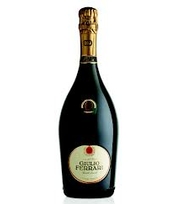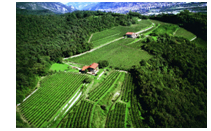|
|
 |

To the extent that you think about Italian sparkling wine, if you think about it at all, you are probably most familiar with the refreshing aperitif bubbly, prosecco. Attractive pricing and improved quality have strengthened demand for and the availability of prosecco in recent years.
You also might have a passing acquaintance with Asti spumante, the exotically perfumed dessert bubbly, particularly if you’ve attended an Italian wedding recently. Few wines go better with wedding cake or traditional Italian cookies.
And if you have a curious and daring palate, you may have taken a trip on the wild side and indulged in a bit of brachetto d’Aqui, the bright red bubbly from Piedmont that goes both ways, either as an aperitif or with, especially with, fruit-based desserts.
 If this has been your experience, then you’ve missed the finest in bubbly that Italy has to offer. These are the sparkling wines labeled Metodo Classico, indicating they have been made using the classic technique of Champagne, which involves a second fermentation in the bottle and extended aging on the so-called “lees”, or dead yeast cells. If this has been your experience, then you’ve missed the finest in bubbly that Italy has to offer. These are the sparkling wines labeled Metodo Classico, indicating they have been made using the classic technique of Champagne, which involves a second fermentation in the bottle and extended aging on the so-called “lees”, or dead yeast cells.
The top metodo classic bubblies of Italy are produced in the north, in Franciacorta and Trento. These wines, along with a handful of California bubblies, are the only sparkling wines in the world that come close to Champagne in terms of quality and prestige.
The luxury category of Italian sparkling wine is small, dominated by three wineries – Ca’ del Bosco and Bella Vista in Franciacorta, and Ferrari in Trento. Of those three, Ferrari bears added significance because it was Giulio Ferrari at the turn of the 20th century who introduced the Champagne technique to Italy, after studying the process in Epernay, France.
Ferrari also insisted that the grape varieties of Chamagne, particularly pinot noir and chardonnay, be planted in the Trentino district that surrounds the village of Trento. The sloping, mountainous vineyards of Trentino are situated in the Dolomites, along the banks of the Adige river. The chardonnay planted by Giulio Ferrari was the first chardonnay grown in Italy, and its importance is difficult to overstate.
Three of Ferrari’s cuvees – Ferrari Brut ($25), Ferrari Perle ($35) and Giulio Ferrari Riserva del Fondatore ($100) – are blanc de blancs, or 100 percent chardonnay. Chardonnay is the grape that imparts the structure and elegance for which Ferrari is famed, and it is the backbone that gives Ferrari its exceptional capacity to age.
The 2001 Giulio Ferrari, for example, was aged 10 years prior to disgorgement (this is when the dead yeast cells are removed and the original airtight cap is replaced with a cork) yet tastes as fresh as the day it was bottled.
“It is,” said Ferrari brand ambassador Jamie Stewart, “a little bit like having a grand cru white Burgundy with bubbles.”
 This particular vintage of Giulio Ferrari is hands down the finest Italian sparkling wine I have ever tasted. Yet it is not the end all and be all of the Ferrari story. Giulio sold the winery to the Lunelli family in 1952 and it remains a family affair to this day, with Matteo Lunelli the keeper of the flame. He has Ferrari positioned as the No. 1 producer of metodo classic in Italy and intends to keep it there. This particular vintage of Giulio Ferrari is hands down the finest Italian sparkling wine I have ever tasted. Yet it is not the end all and be all of the Ferrari story. Giulio sold the winery to the Lunelli family in 1952 and it remains a family affair to this day, with Matteo Lunelli the keeper of the flame. He has Ferrari positioned as the No. 1 producer of metodo classic in Italy and intends to keep it there.
He cited Ferrari’s work in the vineyard, for example, as we tasted the 2004 Perle Rose ($75), which is 80 percent pinot noir and 20 percent chardonnay.
“The typical yield for pinot noir in Trento is 15 tons per hectare (approximately 2 ½ acres) while our yields for pinot are eight to nine tons per hectare,” Lunelli said, explaining that Ferrari cuts away a good deal of fruit from each vine to increase flavor intensity through the growing season. “We also use sustainable growing practices to ensure we have healthy fruit.”
Of course, no winery can exist financially living at the high end. Ferrari Brut is the top selling metodo classic brut in Italy, and at $25 it’s among the finest values in sparkling wine in the world. It is remarkably fresh and clean, and renowned for its finesse.
Of course, you may still prefer a bottle of Champagne when you reach for the bubbly this holiday season; nothing wrong with that, so long as you don’t mind paying a little more for quality that is roughly equal. As for myself, I will continue to drink my fair share of Champagne, but I plan to make Italian metodo classico part of the conversation.
Email questions to whitleyonwine@yahoo.com. Follow Robert on Twitter @wineguru.
|
 |
|